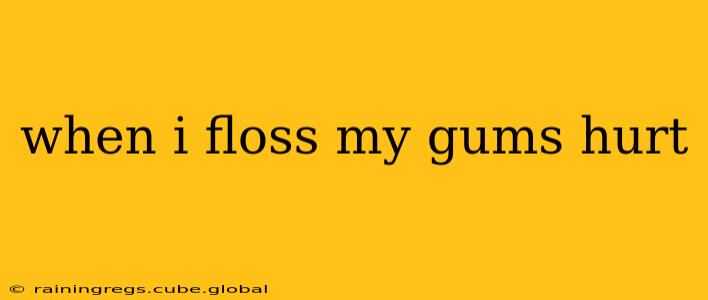Many people experience gum discomfort when they first start flossing or when they haven't flossed regularly. This is often a temporary issue, but understanding the causes and how to address them is crucial for maintaining good oral hygiene. Let's delve into why flossing might hurt your gums and what you can do about it.
Why Does Flossing Hurt My Gums?
The most common reason for gum pain after flossing is gingivitis, the early stage of gum disease. Gingivitis is characterized by inflamed gums that are often red, swollen, and bleed easily. When you floss, you're disrupting the plaque and bacteria buildup along the gum line, which can cause temporary bleeding and discomfort. This isn't necessarily a bad thing; it means the floss is doing its job, but it highlights the need for improved oral hygiene.
Another reason for experiencing pain is improper flossing technique. If you're snapping the floss against your gums or forcing it too aggressively between your teeth, you'll likely cause irritation and bleeding. Gentle, careful flossing is key to preventing this.
How Can I Make Flossing Less Painful?
Here are several strategies to minimize or eliminate gum pain associated with flossing:
1. Start Slowly and Gently:
Don't try to floss perfectly on your first attempt. Begin by gently working the floss between your teeth, and avoid snapping it against your gums. Use a sawing motion to navigate tight spaces. Focus on reaching the gum line without forcing the floss.
2. Use the Right Flossing Technique:
- Use about 18 inches of floss: Wrap most of it around your middle fingers, leaving about an inch to work with.
- Guide the floss gently between your teeth: Use your thumbs and index fingers to control the floss.
- Curve the floss around each tooth: Gently hug the tooth's shape, making sure to reach below the gum line.
- Use a clean section of floss for each tooth: This prevents spreading bacteria.
3. Choose the Right Floss:
Experiment with different types of floss to find what works best for you. Consider:
- Waxed floss: This type slides more easily between tight teeth.
- Unwaxed floss: Offers better grip for removing plaque.
- Dental tape: Wider and flatter than traditional floss, it might be more comfortable for some.
- Floss picks: These pre-threaded flossers can be easier to handle, especially for those with dexterity issues.
4. Be Patient and Persistent:
Consistent flossing is crucial, even if your gums are sensitive. As your gums heal and become healthier, the pain will subside. If bleeding continues after a few weeks of gentle flossing, consult your dentist.
What If My Gums Still Hurt After Trying These Tips?
If the pain persists despite gentle flossing and proper technique, it's essential to consult a dentist or dental hygienist. They can determine the underlying cause of your gum pain, which could be:
- Severe gingivitis or periodontitis: More advanced gum disease requires professional treatment.
- Other oral health issues: Such as gum recession, abscesses, or other conditions.
- Underlying medical conditions: Certain medical conditions can impact gum health.
How Often Should I Floss?
Ideally, you should floss at least once a day, preferably before brushing your teeth at night. This allows for the removal of food particles and plaque that have accumulated throughout the day.
Can I Use Mouthwash to Help with Sore Gums?
Therapeutic mouthwashes containing chlorhexidine or essential oils can help reduce inflammation and promote healing. However, these should be used as directed by your dentist and shouldn't replace proper brushing and flossing.
Remember, healthy gums are vital for overall oral health. Addressing gum pain promptly and adopting a consistent flossing routine are essential steps in maintaining a healthy and beautiful smile. If you're unsure about your flossing technique or experiencing persistent gum pain, seeking professional advice is always recommended.
